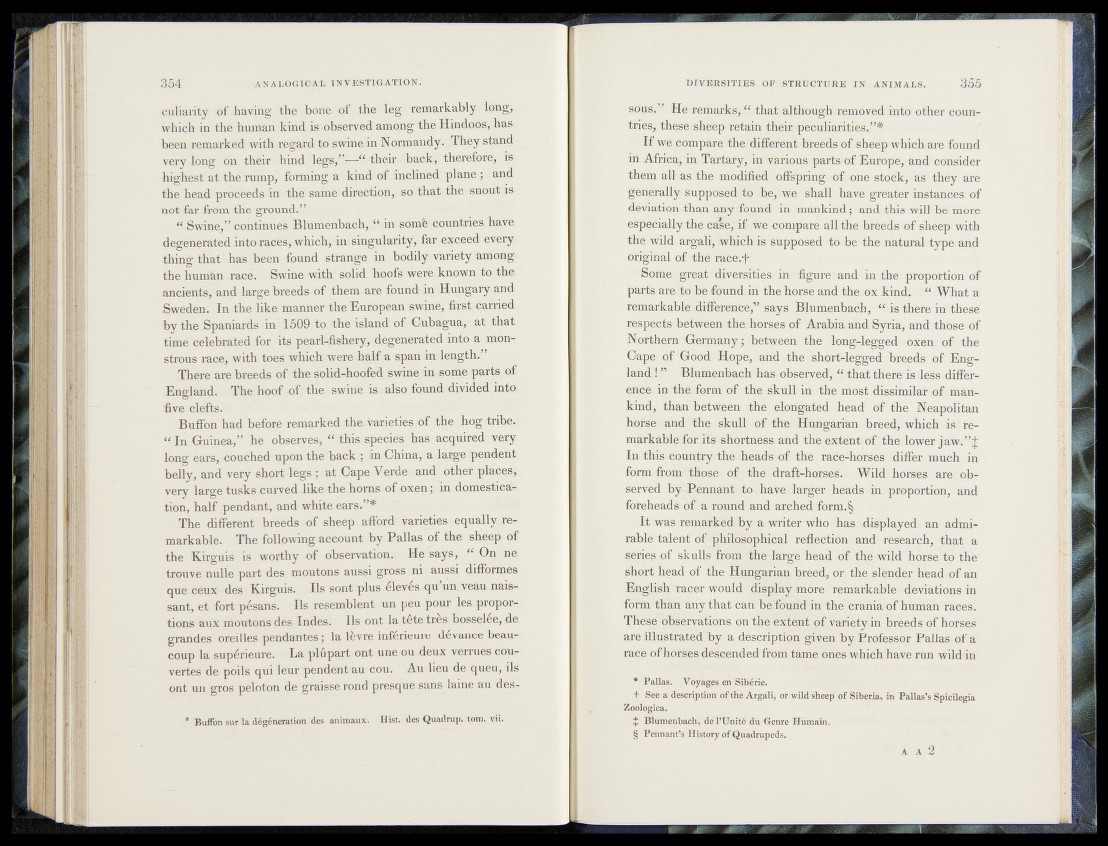
culiarity of having the bone of the leg remarkably long;
which in the human kind is observed among the Hindoos, has
been remarked with regard to swine in Normandy. They stand
very long on their hind legs,”—u their back, therefore, is
highest at the rump, forming a kind of inclined plane ; and
the head proceeds in the' same direction, so that the snout is
not far from the ground.”
u Swine,” continues Blumenbach, u in somfe countries have
degenerated intotaces, whichyin singularity, far exceed every ,,
thing that has been found strange in bodily variety among-
the hum&n race. Swine with solid hoofs were known to the
ancients, and large breeds of them are found in Hungary and
Sweden. In the like manner the European swine, first carried
by theJàpaniards in 1509 to the island of C u b ag u a ;a t that
time celebrated for its pearl-fishery, degenerated'into a monstrous
race, with toes which: were half a span in length.
There are breeds of the solid-hoofed Swine in some parts of
England. The hoof o f the swine is also o found divided into
five clefts.
Buffon had before remarked the; varieties of the hog tribe.
« In Guinea,” he observes, “ this species has acquired very
long ears, couched upon the back ; an China, a large pendent
belly, and very short legs ; at Cape Verde and other places,
very large tusks curved like the horns of oxen; in domestication,
half pendant, and white ears.”*
The different breéds of sheep afford varieties equally remarkable;
The following account by Pallas of the sheep of
the Kirguis is worthy of observation. He says, “ On ne
trouve nulle part des; moutons aussi gross ni aussi difformes
que ceux des Kirguis. Ils sont plus éleves qu un veau naissant,
et fort pésans. Ils resemblent un peu pour les proportions
aux moutons des Indes. Ils ont la tête très bosselee, de
grandes oreilles pendantes ; la lèvre inférieure dévance beaucoup
la supérieure. La plûpart ont une ou deux verrues couvertes
de poils qui leur pendent au cou. Au lieu de queu, ils
ont un gros peloton de-graisse rond presque sans laine au des-
* Buffon sur la dégéneration des animaux. Hist, des Quadrup. tom. vii.
sous.” He remarks, “ that although removed into other countries,
these-sheep retain their peculiarities.”*
If we compare the different breeds of sheep which are found
in Africa, in Tartary, in various parts of Europe, and consider
them all-as the modified offspring,} of one stock, as they are
generally supposed to be, we shall have greater instances o f
deviation than .any i found in mankind; and this will be- more
, especially the calie, if ofcfie compare dll the breeds of sheep with
the wild argali, which is supposed to be the natural type and
original of the race.f
Some great diversities in figure»and' in the proportion of
parts are:to. be found in the horSe and the ox kind; “ What a
remarkable^difference,” says Blumenbach, “ is there in these
respects between the horses of Arabia and Syria, and those of
Northern Germany; between the long-legged,foxen of the
^ a p e of Good* Hope, and the short-legged breeds of England
!” Blumenbach has observed* “ that there is less difference.
in the form of the skull in the most dissimilar of mankind,
than between the elongated head of the Neapolitan
horse and the skull of the Hungarian breed, which is remarkable
for its shortness and the extent o f the lower jaw.” t
In this ‘.country thè heads of the, race-horses differ much in
form from those of the draft-horses. Wild horses are observed
by-Bennant to have larger heads in proportion, and
foreheads of a round and arched form.§
It was remarked By a writer who has displayed an admirable
talent óf philosophical reflection and research, that a
series of skulls from the large head of the wild horse to the
short head of the Hungarian breed, or the slender head of an
English racer would display more remarkable deviations in
form than âny that can be found in the brania Of human races.
These observations on the extent ©f variety in breeds of horses
are illustrated by a description given, by Professor Pallas of a
race of horses descended from tame ones which have run wild in
* Pallas. Voyages en Sibérie.
t See a description of the Argali, or wild sheep of Siberia, in Pallas’s Spicilegia
Zoologica.
* J Blumenbach, de 1’UnM'du Genre Humain.
§ Pennant’s History of Quadrupeds.
A A 2